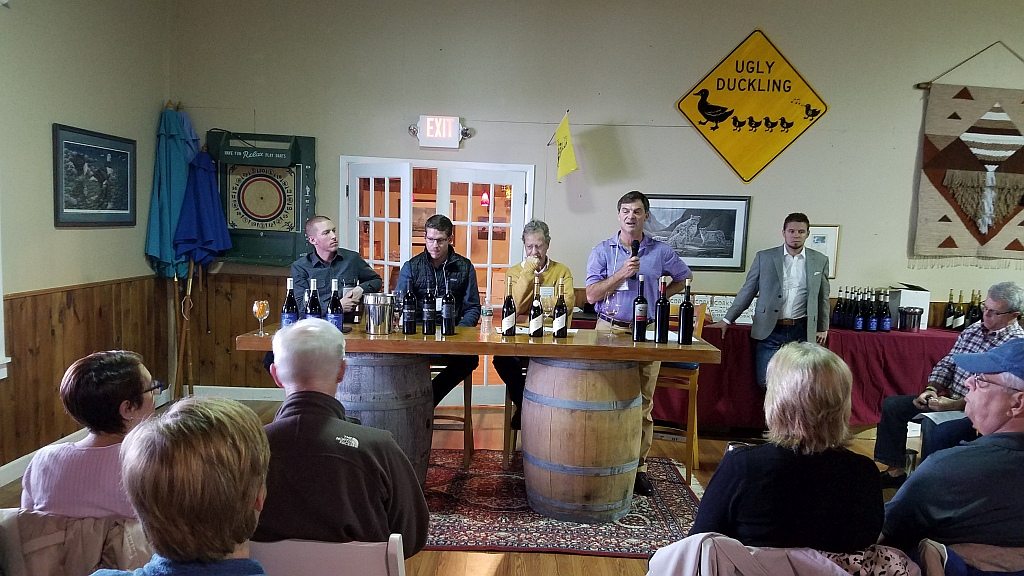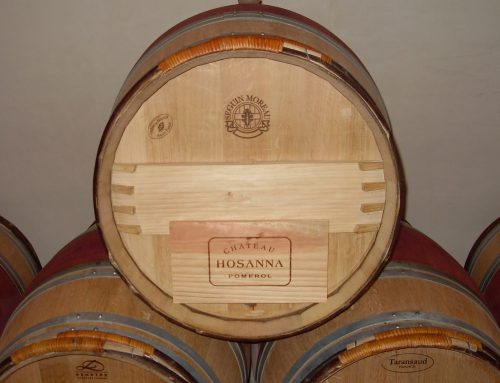New Jersey Winemakers Co-op tasting, Mark Carduner, owner of Working Dog Winery speaking
This is the first in a sometimes series looking at o unlikely wine-producing states.
About two decades ago, I tasted wines from Texas and thought it an amusing idea: Texans with 10-gallon cowboy hats and alligator boots offering homespun chardonnay and cabernet sauvignon. It was not the image of cowboys on horseback herding cattle across sagebrush-dotted plains.
Similarly is the picture of New Jersey as wine country: a state with the densest per square mile population in America, divided by the unglamorous New Jersey turnpike (is any turnpike or autoroute glamorous?) and formed by cut-and-diced suburban towns. Yet, it is a state striving to make high-quality wines in its sandy soils, its sometimes freezing—other times hot and humid, and always unpredictable—northeastern weather. The image of Napa Valley or Tuscan vineyard areas it’s not.
I’ve been tasting and writing about New Jersey wines since 1985 (my first article had the cheeky title “Parkway Red and Turnpike White”. Yet despite its rough and tumble image, this state also has its genteel side: it is, after all the Garden State, and it’s second only to Kentucky in race-horse farms. And it has constantly improved its vinifera wines.
During the last six months, I’ve tasted a selection of wines from this most unlikely state. Recently, four of New Jersey’s best wineries formed the Winemakers Co-Op, in an effort to promote their wines. At their fall 2017 tasting, each presented three vintages of a single wine from their portfolio. And now I present to you my notes that may cause you to reconsider any prejudice toward New Jersey wines.
William Heritage Winery located in Mullica Hills, is part of the Outer Coastal Plain AVA (American Vinicultural Area) in Southeastern New Jersey.
Sean Comminos, winemaker William Heritage Winery
In 1999, fifth-generation owners William and Penni Heritage, began converting their 1853 farm from a 150-acre fruit orchard to vineyards. In 2001, they established the winery with 40 acres planted with traditional Bordeaux grapes, along with syrah, chardonnay, sauvignon blanc, and chambourcin, the latter a French-American hybrid that produces a cinnamon-scented wine that I find particularly appealing.
In 2012, I was a judge on a panel that in a blind tasting ranked the 2010 Heritage Winery BDX—the initials are an abbreviation for Bordeaux—red wine higher than Bordeaux’s renowned Chateaus Montrose and Leoville-Las-Cases.
Heritage began its presentation with the 2010 BDX. Now in a vintage five years older, I found it lacking the fruit flavors I recalled from the tasting in 2012. Instead it was tilted with aromas and flavors of black tea, herbal and tobacco. While appealing, it was not at the level of Chateaus Montrose and Leoville-Las-Cases. 85 points.
The 2014 Heritage BDX is 57% merlot, 18% malbec, 11% petit verdot, and 7% each cabernets sauvignon and franc aged in French oak barrels. The blend produced a pleasant blackberry color, tobacco, black fruit and smoky nose. The medium body delivered tasty black tea, black cherry and tobacco flavors bound with the soft tannins that makes it drinkable and very pleasing. 88 points. While the 2015 BDX was a radically different blend of 47% cabernet sauvignon, 41% merlot and 13% cabernet franc. It had the same color spectrum and tobacco accent, but riper, black cherry aroma and flavor bound to its medium body. 88 points.
Beneduce Vineyards is a 16-acre vineyard in Pittstown, a farm area in the western section of central New Jersey, where fourth-generation family members Mike Beneduce and his sister Justen Beneduce Hiles are the winemaker and general manager, respectively.
Mike Beneduce
In 2010, Beneduce graduated from Cornell University with dual degrees in plant science and viticulture and enology. He is also a certified sommelier. Two years earlier, Hiles received her degree in agriculture science from Rutgers University.
Their Blue 2 wine comes from estate-grown Blaufrankisch, a thick-skinned red wine grape best known in Austria that Beneduce believes is suitable for his cool-climate location.
The 2013 Beneduce Vineyards Blue 2 had an enticing Chinese five-spice powder aroma and its light body carried a tasty, red-berry and cinnamon flavor with a touch of minerality in the finish. 86 points. The 2014 Blue 2 brought black cherry and a smoky accent to its aroma. Its medium body was wrapped with a pleasing black-fruit flavor and soft tannins. 86 points. The final wine of the trio, 2015 Blue 2 was the darkest colored and least appealing as the black fruit and cola-scented and-flavored wine was dull on the palate. 82 points.
The three wines have only 220 to 240 cases each, and alcohol is a mild 12.6% to 12.9%.
Time will tell if Blaufrankisch is a wise choice for the soil and climate of Beneduce Vineyards. The grape’s obscurity adds its own marketing challenge, but today’s young winemakers welcome these sorts of challenges.
An hour southeast of Beneduce Vineyards is Working Dog Winery in Robbinsville. In 2001, a casual conversation about how the novelty of winemaking led brothers Mark and Brian Carduner to plant 1.5 acres of cabernet franc. Another acre was planted the following year (along with purchasing the adjacent 100-acre farm), and two more in 2006. By 2018, the vineyard expanded to 20 acres.
Chardonnay, viognier and riesling are the planted white varieties, and merlot, syrah, sangiovese, and cabernet franc are the reds. Mark Carduner considers cabernet franc its best grape; it occupies 25% of the vineyard.
A tasting of current vintages began with the 2013 Working Dog Winery Cabernet Franc. As I noted its black cherry color, and smoky black tea aroma (12.8% alcohol), Carduner said the vineyard had only seven inches of rain in 2013. But I was concentrating on the very tasty black cherry and blackberry flavors that were stitched to a medium body with a mineral backbone and very ripe fruit in the finish. 89 points.
The 2014 Working Dog Winery Cabernet Franc Reserve was made from grapes of its oldest vines with reduced yields. It was aged in two new oak barrels, from Virginia and Pennsylvania, respectively, and yielded a minuscule 52 cases.
Its black-pepper accent adds to the appeal of the black cherry, smoky aromas, and the dense blackberry flavor is bound with firm tannins with a medium body that was balanced throughout the long finish. 90 points.
Next up: a barrel sample of the 2015 Working Dog Winery Cabernet Franc. Carduner said it was the ripest vintage since 2010, and its 13.3% alcohol was the highest of the three wines.
The 2015 had the same black cherry color as the two previous wines, but displayed a wider range of aromas from blackberry to black tea and tobacco. A medium body built around ripe blackberry flavors with balancing tannins finished with a dry, appealing Darjeeling tea taste. 89 points.
Unionville Vineyards, owned by Robert (Bob) Wilson, the former vice-chairman of Johnson & Johnson, is in Ringoes, a small village in the western section of central New Jersey.
I have tasted Unionville’s wines on a number of occasions and have found their Pheasant Hill vineyard chardonnay and pinot noir to be of exceptional quality and Burgundian-styled. So, I had high expectations when it was announced that the Pheasant Hill vineyard Syrah would be presented.
The 15-acre vineyard, planted in 1999 and 2007, is divided into two plots. The first plot is on loamy sandstone soil with a southeastern exposure and devoted solely to chardonnay for the Pheasant Hill single-vineyard bottling. I have tasted various vintages of this wine, and all had the style of a premier cru Chassagne-Montrachet.
The second plot is composed of slightly acidic, silt-loam soil and devoted to pinot noir, and the Rhone varieties mourvedre, viognier and syrah. It excellent years, all five varieties are bottled as single-vineyard wines.
We started our tasting with the 2010 Unionville Vineyards Pheasant Hill Vineyard Syrah. It was blackberry colored with black raisin, dark chocolate and a mild smoky nose. The medium body transported tasty, blackberry and plum flavors with just the slightest touch of syrah’s black-pepper personality. Soft tannins carried the fruit-flavored wine to a pleasing finish. 87 points. The 2012 Pheasant Hill Vineyard Syrah was more red-fruit driven. Its black cherry color and flavor had accents of raspberry and white pepper. A lighter body than the 2010 was wrapped with black cherry, red plum and white pepper flavors that glided to a balanced finish. 85 points. The 2014 Pheasant Hill Vineyard Syrah followed the path of the 2012 wine with its black cherry and white-pepper character, but had the medium body palate weight of the 2010 bottling. A tasty, black cherry flavor comingled with the stony, mineral like finish. 86 points.
As pleasant as the syrah wines were, I think the Unionville’s Pheasant Hill vineyard chardonnay and pinot noir wines are a notch above this trio of syrahs.
The DNA of New Jersey vinifera wines features soft tannins and alcohol levels of 12 to 13 percent, making them both very drinkable on their own and ideal partners with food. In an era in which winemaking techniques and nature drive alcohol levels for many red wines into the 14% to 16% range, extra-ripe fruit fashion, and new oak-saturated wine, New Jersey’s wines can seem like a step back in time. But drinking balanced, flavorful wine has never been out of fashion.
The volume and distribution of the wines is limited. It is best to contact the winery for availability.
Next: A visit to the Lone Star state.
Photos by John Foy













Leave A Comment